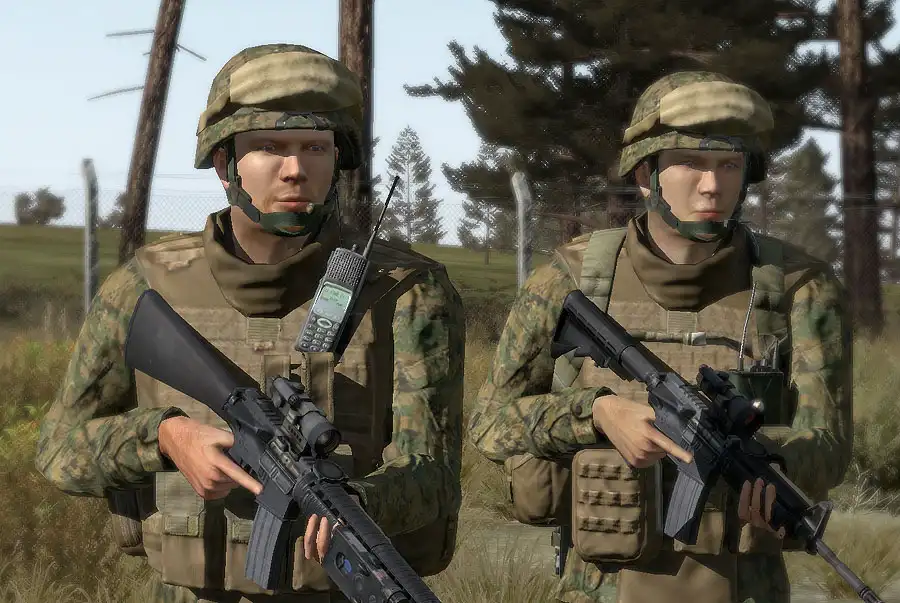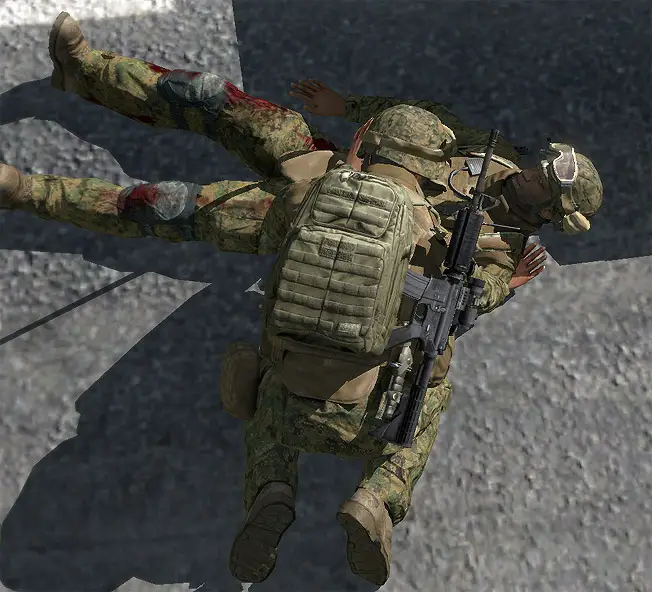![]()
Squad Structure & Leadership 
Squad Organization & Purpose 
ShackTacライフル分隊は強力な部隊です。4人のプレイヤーからなる3つのファイアチームと、2人のプレーヤーからなる分隊指揮部隊で構成されます。この14人プレーヤーのユニットは戦場の流れに大きな影響を与えることができます。
A squad is typically lead by a Specialist, Corporal, or NCO, but can also be lead by Regulars aspiring to higher leadership.
通常、分隊は技術兵、伍長、下士官(NCO)などにより指揮されますが、より高度な指揮に野心的な古参兵によっても指揮されます。
Squads consist of an impressive array of firepower, and are just as well-rounded as the fireteams that they are composed of. In addition to their ability to inflict significant harm, they also are accompanied by a corpsman (medic) who can tend to any wounds that may be received through the course of a fight. He acts as the second man in the two-man Squad Leader element, providing security for the Squad Leader when he's not tasked out with tending to wounded squad members.
分隊は、眼を見張るような火力を持っており、同じように構造されたファイアチームと同様の汎用性があります。また、重大な損害を加えることのできる彼らの能力に加えて、戦闘中のどんな負傷にも対応できる衛生兵(Medic)が同伴します。彼は2人から成る分隊長部隊(Squad Leader element)における2番目として行動します。彼が負傷した分隊のメンバーの治療をしていない時、分隊長部隊(Squad Leader element)の警備を提供します。
The order of leadership succession in a squad goes from the Squad Leader to the first, second, and finally the third fireteam leaders.
分隊における指揮権の移譲の命令は、分隊長から1番目のファイアチームリーダー、同様に2番、3番と続きます。
 Squad Leader Responsibilities
Squad Leader Responsibilities 
The Squad Leader has similar responsibilities to the Fireteam Leader, except instead of controlling individual players, he controls entire fireteams. He is tasked with leading his squad in accordance with the Platoon Commander's intent and direction, as well as coordinating laterally with his fellow squads. The squad leader's motto is to "Lead from the front", since they know that they cannot direct their fireteams most efficiently if they cannot observe their movements and combat.
分隊長はすべてのファイアチームを管理し、個々のプレイヤーを管理しないことを除けば、ファイアチームリーダーと同様の責任を持っています。小隊長の意図と指示通りに分隊を率いて、彼の分隊と釣合う仕事を与えられます。分隊長の座右の銘は「前線からの指示」です 。なぜなら、もし戦闘や移動を観測できなければ、最も効果的にファイアチームを指揮できないと彼らは知っているからです。
Squad leaders... 
- Get their direction from the Platoon Commander. They are expected to be able to take a broad goal set by the Platoon Commander and turn it into a plan that they can pass down to their fireteam leaders. This includes setting rules of engagement, formations, waypoints, rally points, movement speeds, and any other relevant information.
- 小隊長からの命令を受けること。 分隊長には小隊長から大局的な目標を受け取り、それをファイアチームリーダーへの具体的な計画にすることです。これは交戦規則や陣形、経路、集会地点、移動速度、およびその他いかなる関連情報の設定も含んでいます。
- Ensure that their team leaders and squad members know what the plan is. The "commander's intent" is conveyed to all squad members so that whatever happens, regardless of casualties, everyone knows what the end goal is and can adapt and work towards that with flexibility and responsiveness.
- 確実にファイアチームリーダーと分隊のメンバーが計画を知っているようにすること。 たとえ何が起ころうと、全員が最終目的は何であるかを知っており、それに向けて臨機応変に行動できるように、「指揮官の意図」は全ての分隊員に伝えます。
- Position themselves so that they can best observe their fireteams and exercise command and control over them. A squad leader who isn't staying close to his fireteams is quickly rendered ineffective. Squad leaders must always be with their fireteams, in a position from which they can make sound and timely tactical judgments and issue clear and appropriate orders. Typically a squad leader will be just behind the 'front line', positioned to where he can see as much of his squad as the tactical situation allows for.
- 指揮下のファイアチームが最もよく見える位置につき、指揮統制すること。 ファイアチームの近くにいない分隊長は役に立ちません。分隊長は迅速で適切な戦術的判断と明確で適切な指示が可能な場所で、常にファイアチームと一緒にいなければいけません。一般に、分隊長は前線のすぐ後ろ、つまり可能な限り分隊と同じ量の情報が取得可能な場所にいるでしょう。
- Dictate squad formations, rules of engagement, and general combat posture, adapting to the situation at hand and the Platoon Commander's guidance. The squad leader must be ever vigilant regarding the tactical situation and must be able to make timely adjustments to the squad's formation, ROE, posture, and more.
- 現状と小隊長の指導に応じて、分隊の構成や交戦規則(RoE)、および総合的な戦闘への構えを指示すること。 分隊長は戦況について用心深くあるべきで、分隊の陣形や交戦規定(RoE)、戦闘への構えなどを迅速に判断しなくてはいけません。
- Communicate key information across to other squad leaders and up to the Platoon Commander. This includes information like casualties incurred, enemy contacts, ammunition status, and other vital pieces of information that maintain the platoon's situational awareness and assist the other squad leaders and platoon commander in their planning. This also requires a good understanding of how to employ the "Channel Commander" functionality of our Teamspeak setup, as well as being able to be concise and clear in speaking on that channel.
- 重要な情報を他の分隊長や小隊長と共有すること。 死傷者、接敵、弾薬の状態、また他の分隊長や小隊長の作戦立案の手助けとなる情報や小隊長の状況把握に必要不可欠な情報などが含まれます。またShackTacのTeamspeakに設定された指揮官チャンネル(Channel Commander)の使い方やそこにおける簡潔で明快な話し方をよく理解することが求められます。
- Maintain situational awareness on the platoon's disposition, as well as that of the enemy. Knowing where friendly forces are is critical to avoiding friendly fire incidents, and knowing where the enemy is gives the squad leader important information to use in making tactical decisions. The SL should be actively telling his squad members where friendly forces are, to ensure that the risk of blue-on-blue is minimized.
- 敵の動向と同様に、小隊の動向についても常に把握すること。 友軍がどこにいるのかを知っていることは友軍への誤射を回避することに不可欠です。また、敵がどこにいるのかを知ることは戦術的決定をする際に重要な情報を分隊長に与えます。分隊長は誤射の危険を最小限にするために友軍がどこにいるのかを積極的に分隊員に伝えるべきです。
- Wield their fireteams as their weapons by directing and controlling their fire, picking out and assigning key targets, and maneuvering the fireteams across the battlefield. A squad leader who is giving good, timely orders, maneuvering his fireteams through combat and directing their fire, does far more damage to the enemy than one who is preoccupied with his own rifle. A squad leader avoids becoming personally engaged in firefights when possible, instead focusing on designating targets, maintaining awareness of the tactical situation, communicating with higher, maneuvering the teams, directing and controlling their fires, and coordinating the handling of any casualties that occur. The squad leader may use his rifle's tracers to direct fire, or M203 smoke or flare rounds to designate targets or screen movement, but he generally spends more time commanding than he does shooting. This has the additional benefit of making him less likely to draw the attention of the enemy, and helps to prevent 'tunnel vision' from taking effect.
- ファイアチームの射撃を指揮したり、機動させたりすることによって、それらを自分の武器として駆使すること。 戦闘中にファイアチームの射撃指揮をしたり機動させたりと適切な命令を与えている分隊長は、彼自身のライフルに気を取られる分隊長より遥かに多くの損害を敵に与えます。分隊長はできるだけ個人的な銃撃戦に参加する事を避け、戦況の把握に努め、上級指揮官との交信、ファイアチームの機動、射撃の指揮と管理、発生した死傷者の取り扱いなどの調整をします。分隊長は射撃を指揮するために曳光弾を使ったり、移動する際の目隠しに発煙弾や照明弾を使用しますが、一般に分隊長は射撃をするより多くの時間を指揮に費やします。これには敵の注意を引かないようすることに加えて、視野狭窄(tunnel vision)に陥ることを防ぐ助けにもなります。
- Know how to consolidate and reorganize teams when casualties occur. This includes using group management features in an expedient fashion, as well as consolidating communication channels when required.
- 死傷者が発生した時にどのようにチームを再編成するか理解すること。 これは都合の良いようにグループを管理したり、必要な場合は交信に使うチャンネルを統合することも含まれます。
- Keep his squad tied-in with other friendly squads when moving in a platoon formation. The SL must stay aware of how close his squad is to other squads, to ensure that dangerous gaps do not develop in the overall formation. The tighter and more broken the terrain, the more important this becomes.
- 小隊で陣形を組んで移動するときは味方の分隊から離れないようにすること。 分隊長は常に他の分隊との距離を意識し、小隊の陣形に危険な空白地帯ができないようにしてください。
Squad Roles 
Squad Medic / Corpsman 
When so many rounds are flying around, someone's bound to get hit sooner or later. Unfortunately, this 'someone' is occasionally a fellow squad member. When it happens, the squad medic is the man to turn to. The squad medic is critically important - they are the key to maintaining the combat effectiveness of the squad when heavy contact has been made.
大量の弾丸が飛び交っているとき、遅かれ早かれ誰かが被弾します。残念ながら、この「誰か」は分隊員です。それが起こった時、分隊の衛生兵(medic/corpsman)は頼りになります。激しい交戦になったときに分隊の戦闘能力を維持するために分隊付衛生兵は極めて重要です。
Squad medics... 
- Are concerned first and foremost with the welfare of their squad members. While a medic carries a rifle, it is nowhere near as powerful as the skill he brings as a healer. Medics leave the fighting to the infantry, instead focusing on patching up the wounded and getting them back into the fight. Medics should only fire their weapon in self-defense, or in the defense of the wounded.
- 分隊員の健康状態を意識すること。 衛生兵はライフルを持っていますが、これは彼が医師としてもたらす技能の強さに到底及びません。衛生兵は戦いを歩兵に任せる代わりに負傷者を手当てして、彼らを戦闘に復帰する事に専念します。衛生兵は自衛または負傷者の防衛においてのみ発砲するべきです。
- Stay a bit back off of the front line. This gives the medic a view of the bulk of the squad disposition and helps to prevent tunnel vision. By staying off of the front line, the medic is able to maneuver to different fireteams more easily in response to people being wounded, without drawing the same kind of fire as a frontline player.
- 前線の少しだけ後方にいること。 分隊の配置の大部分を視界に収めることで状況の把握に役立ちます。最前線から少し下がって待機する事によって、衛生兵は敵の砲火に移動を制限されることなく負傷者を出したファイアチームへ容易に駆けつけることができます。
- Look out for their Squad Leader and provide rear and flank security when not acting in a medical capacity. The squad leader often is preoccupied with commanding his fireteams, leaving him less time to watch his back and flanks. The medic fills this gap whenever not actively helping out wounded players.
- 治療していない時は分隊長を探して、後方と側面の警備をすること。 分隊長はしばしば背後と側面に気をつける時間をファイアチームの指揮に使ってしまいます。救護するべき負傷者が居ない時は衛生兵がこの隙間を補います。
- Are comfortable with using smoke to provide concealment for the wounded. Medics carry a number of smoke grenades that are intended to be used to conceal wounded players so that someone else can rush out and drag them to safety. Knowing where and when to throw these smoke grenades is a key skill for a medic to develop. He must be conscious of masking the wounded person from enemy observation, while at the same time not compromising the visibility of friendly elements.
- 負傷者を隠す為に煙幕を張ること。 衛生兵は多くの発煙筒を携行します。誰かが負傷者の元へ駆けつけ、負傷者を安全な場所まで引きずって来られるように煙幕を張って支援します。いつどこへ発煙筒を投げるべきか判断することは衛生兵が習得するべき重要な技能です。敵の視界から負傷者を隠すのと同時に、その煙幕が味方の視界を遮ることのないよう留意しなくてはなりません。
- Triage their patients. In
 , a medic must be able to rapidly diagnosis casualties and pick out the ones that need the most urgent attention. Find those who are heavily bleeding, have had their hearts stop, or otherwise are urgent cases. People who have been lightly wounded and are in pain can wait - the urgent ones cannot.
, a medic must be able to rapidly diagnosis casualties and pick out the ones that need the most urgent attention. Find those who are heavily bleeding, have had their hearts stop, or otherwise are urgent cases. People who have been lightly wounded and are in pain can wait - the urgent ones cannot. - 負傷者を選別すること。
 では、衛生兵は複数の負傷者を迅速に診断し、誰を先に治療するのか順番を決めなければなりません。大量出血や心臓停止、あるいはそれ以外に急を要する人を見つけてください。出血の軽い者や、痛みを感じているだけの者を待たせておいても死にませんが、瀕死の重症者を待たせることはできません。
では、衛生兵は複数の負傷者を迅速に診断し、誰を先に治療するのか順番を決めなければなりません。大量出血や心臓停止、あるいはそれ以外に急を要する人を見つけてください。出血の軽い者や、痛みを感じているだけの者を待たせておいても死にませんが、瀕死の重症者を待たせることはできません。 - Know how to properly deal with battle damage. In
 , the medic has three basic medical supplies that can be used to address various damage aspects. The first is the bandage - this simply reduces or stops bleeding. The second is morphine, which reduces a player's pain and the associated penalties. Finally, there is epinephrine. "Epi" for short, this is used to restart a person's heart if they go into cardiac arrest. Without "epi", a heavily wounded heart-stopped player will die in short order. With it, he may very well survive.
, the medic has three basic medical supplies that can be used to address various damage aspects. The first is the bandage - this simply reduces or stops bleeding. The second is morphine, which reduces a player's pain and the associated penalties. Finally, there is epinephrine. "Epi" for short, this is used to restart a person's heart if they go into cardiac arrest. Without "epi", a heavily wounded heart-stopped player will die in short order. With it, he may very well survive. - 的確に戦闘での負傷に対処する方法を知ること。
 では、様々な損害状況を処理するのに使用できる3種類の基本的な医療品が衛生兵にあります。1番目は包帯―これは出血を減少させるか完全に止血します。2番目はモルヒネ―モルヒネはプレーヤーの痛みとそれに付随する不利益を減少します。最後はエピネフリン―略して"Epi"は心拍停止したときに心肺蘇生するのに使用されます。"Epi"がなければ、心拍停止した重症のプレーヤーはじきに死んでしまいます。"Epi"があれば生存率は大幅に向上します。
では、様々な損害状況を処理するのに使用できる3種類の基本的な医療品が衛生兵にあります。1番目は包帯―これは出血を減少させるか完全に止血します。2番目はモルヒネ―モルヒネはプレーヤーの痛みとそれに付随する不利益を減少します。最後はエピネフリン―略して"Epi"は心拍停止したときに心肺蘇生するのに使用されます。"Epi"がなければ、心拍停止した重症のプレーヤーはじきに死んでしまいます。"Epi"があれば生存率は大幅に向上します。
 新規
新規 編集
編集 添付
添付 一覧
一覧 最終更新
最終更新 差分
差分 バックアップ
バックアップ 凍結
凍結 複製
複製 名前変更
名前変更 ヘルプ
ヘルプ





